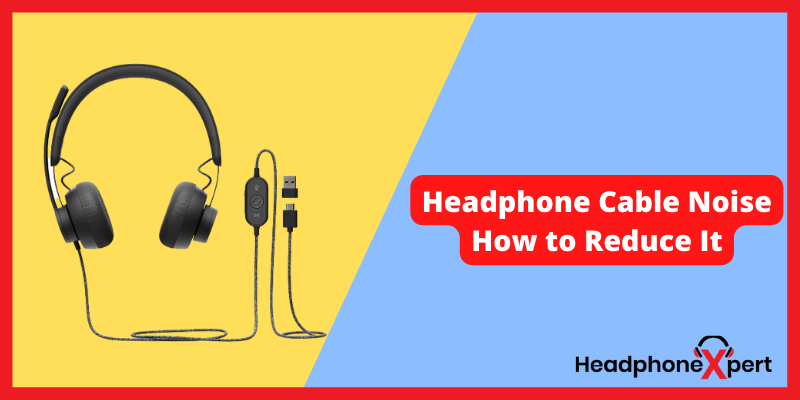Nothing is more annoying than the rubbing and minimal headphones cable noise when you listen to your favorite music. Haven’t you experienced such cable noise yet? If you are an audiophile, you must have experienced this disturbing headphone cable noise. I like to listen to everything in peace, but for different reasons, headphones and cable produce the noise we will discuss in this article.
Cable noise is the disturbing sound of the cable you hear because of the headphone cable interference or rubbing of the cables against the surface, and you will hear the hum or rub. It is common for audio cables to experience it, and cables need to be designed and manufactured so that unwanted line noise, electrostatic hum, crosstalk, and noise induced by cable handling will be minimized or eliminated.
You will learn about the cable noise, its potential causes, and complete guidance on fixing and reducing the headphones’ cable noise in detail. Moreover, there is an illustration of the impact of suitable cable in providing satisfying sound quality.
What causes cable noise?
After a thorough study and research on the different causes of headphone cable noise, I have enlisted the critical reasons for the cable noise resulting from these factors.
Static & Ground Loops
By rubbing against one another, cables can build up static electrons that cause noise, and static electrons build-up due to cables rubbing against one another or being dragged along. An undesirable current flow in the cable shield can cause a buzz, a headphone cable rubbing noise, or a hum when a cable connects two pieces of audio equipment grounded at both ends.
Electromagnetic induction (EMI)
There are two primary causes of buzzing and humping: Electromagnetic induction and constant voltage changes in magnetic fields cause neighboring conductors to produce electrical signals that result in the headphone cable microphonics. Fortunately, a cable is less susceptible to this phenomenon by twisting its inner conductors.
Electrostatic Coupling
The hum is caused by a voltage being electrostatically coupled into the cable resulting from capacitive reactance inherent between power and audio signal lines. The higher the capacitive reactance and the impedance, the louder the hum. Additionally, hum will be more likely to occur if the cable runs for a long distance.
Radiofrequency interference (RFI)
Various equipment is used in complex audio systems, all at different voltage levels and frequencies, and cables, which act as transmission antennas, propagate this radiation. This can result in a buzz or hum by the cables, which also act as receiving antennas.
How to reduce headphone cable noise?
If you want to remove the Earphone cable noise, you can use these practical and potential solutions to avoid such noise.
Clothing Clip
Most of the rubbing and humming sound comes from the wire’s over-the-limit movement, and the clip’s use will cover the most damage that comes in the way.
Cable Noise Filter
Use the cable noise filter or Clip-on Noise Filter to reduce the high-frequency interference of the surrounding electronics.
Use the Short Wire Extension
It is also a practical method that I use to minimize the effect of the noise by using a smaller wire. The longer the cable is, the more the noise will be, so it is better to use the cable you need.
Wrap the Cable around your Ears
Wrapping the headphone cable over your ear will improve the headphone cable sound quality of the headphones. It will lessen the impact of the cable noise, and you will listen to less rubbing noise.
Get the Right Shield Cable
The correct shielding is essential to reducing the impact of signal interference in cables. You can choose from the different types of shields available. The main two are:
- A braided Headphone cable is a mesh-like structure with a conductor that lowers the interference and noise.
- Spiral – in which the wires encapsulate the conductor.
Grounded Cable Sheet
When it comes to eradicating noise, the best solution is the use of a quality wire. The more coverage the cable shield provides, the more effective it is at eliminating this noise.
Insulating material inside the cable shields can dissipate static noise, improve shield density, and reduce noise inherent in normal handling.
Try a New Cable
I have two different cables, short and a long one, and I use them according to my requirements. With different cables, the impact of the noise was different, so better try a new one with the right kind of shield.
Rerouting the Cable
Reroute the wire coming from the headphone, for example, upwards and fastened to the headband, and mechanically transmitted noises will travel partially via the headband and so be muted.
How to reduce IEM Microphonics?
You can remove the Microphonics of the IEM by:
- Using soft wires that avoid noise issues is better than hard wires.
- You can also anchor the cable using the cloth clip or wrapping it around the collars to reduce the IEM cable noise.
- You can use the best quality wired headphones with noise cancelation.
- Using the top-notch cable with a high-quality insulation shield is better.
Final Words
Headphone cable noise is evident if the cable insulation shield is not of good quality or if you avoid the factors like Static, EMI, loop, etc. I have enlisted the key reasons and their pertinent solutions that you can use to avoid these annoying microphonics.
Recommended Articles:
